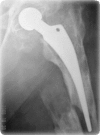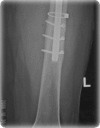Management of late periprosthetic femur fractures: a retrospective cohort of 72 patients
- PMID: 19513712
- PMCID: PMC2903154
- DOI: 10.1007/s00264-009-0815-0
Management of late periprosthetic femur fractures: a retrospective cohort of 72 patients
Abstract
We present our series of 72 patients with periprosthetic fractures. The Vancouver classification was used to evaluate the fractures; there was one type A, seven type B1, 42 type B2, 17 type B3 and five type C fractures. Demographics, pre and postoperative data using Charnley-D'Aubigne-Postel score for assessment of function were recorded. The mean follow-up for all patients was two years. The overall outcome of treatment was graded as excellent, good or poor. An excellent result indicated that the arthroplasty was stable with minimal deformity and no shortening. Stable subsidence of the prosthesis or when the fracture healed with moderate deformity or shortening was deemed as a good result. A loose prosthesis, nonunion, sepsis, severe deformity or shortening was considered poor. In our series 79% (n = 57) had good or excellent results following surgical intervention and 21% (n = 15) had complications; they all had undergone re-operation for various reasons such as nonunion, loosening, dislocation or infection. In B2 fractures the stem is unstable and hence revision of the prosthetic stem has been recommended with or without additional fixation. For B3 fractures an allograft prosthesis composite or tumour prosthesis is considered the treatment choice.
Figures
Similar articles
-
[Periprosthetic Femoral Fractures after Total Hip Replacement: Our Results and Treatment Complications].Acta Chir Orthop Traumatol Cech. 2017;84(1):52-58. Acta Chir Orthop Traumatol Cech. 2017. PMID: 28253947 Czech.
-
Outcomes of Vancouver B2 and B3 periprosthetic femoral fractures after total hip arthroplasty in elderly patients.Hip Int. 2019 Mar;29(2):184-190. doi: 10.1177/1120700018772163. Epub 2018 May 2. Hip Int. 2019. PMID: 29716387
-
Periprosthetic femoral fractures after total hip arthroplasty: An algorithm of treatment.Injury. 2019 Jul;50 Suppl 2:S45-S51. doi: 10.1016/j.injury.2019.01.044. Epub 2019 Feb 2. Injury. 2019. PMID: 30765184
-
Hip Revision Arthroplasty of Periprosthetic Fractures Vancouver B2 and B3 with a Modular Revision Stem: Short-Term Results and Review of Literature.Z Orthop Unfall. 2022 Feb;160(1):40-48. doi: 10.1055/a-1209-4002. Epub 2020 Aug 3. Z Orthop Unfall. 2022. PMID: 32746487 Review. English.
-
The management of type B1 periprosthetic femoral fractures: when to fix and when to revise.Int Orthop. 2015 Sep;39(9):1873-9. doi: 10.1007/s00264-014-2617-2. Epub 2014 Dec 16. Int Orthop. 2015. PMID: 25512137 Review.
Cited by
-
Primary cementless hip arthroplasty as a potential risk factor for non-union after long-stem revision arthroplasty in periprosthetic femoral fractures.Int Orthop. 2015 Apr;39(4):617-22. doi: 10.1007/s00264-014-2489-5. Epub 2014 Aug 17. Int Orthop. 2015. PMID: 25128966
-
Periprosthetic Vancouver type B1 and C fractures treated by locking-plate osteosynthesis: fracture union and reoperations in 60 consecutive fractures.Acta Orthop. 2012 Dec;83(6):648-52. doi: 10.3109/17453674.2012.747925. Epub 2012 Nov 11. Acta Orthop. 2012. PMID: 23140109 Free PMC article.
-
Midterm Results of Consecutive Periprosthetic Femoral Fractures Vancouver Type A and B.Clin Pract. 2016 Aug 24;6(3):871. doi: 10.4081/cp.2016.871. eCollection 2016 Aug 8. Clin Pract. 2016. PMID: 27777712 Free PMC article.
-
Nickel-titanium shape-memory sawtooth-arm embracing fixator for periprosthetic femoral fractures.Int Orthop. 2012 Mar;36(3):619-26. doi: 10.1007/s00264-011-1325-4. Epub 2011 Jul 30. Int Orthop. 2012. PMID: 21805070 Free PMC article.
-
High incidence of stem loosening in association with periprosthetic femur fractures in previously well-fixed cementless grit-blasted tapered-wedge stems.Int Orthop. 2015 Sep;39(9):1689-93. doi: 10.1007/s00264-014-2586-5. Epub 2014 Nov 11. Int Orthop. 2015. PMID: 25385003
References
-
- Duncan CP, Masri BA. Fractures of the femur after hip replacement. Instr Course Lect. 1995;44:293–304. - PubMed
MeSH terms
LinkOut - more resources
Full Text Sources
Medical





